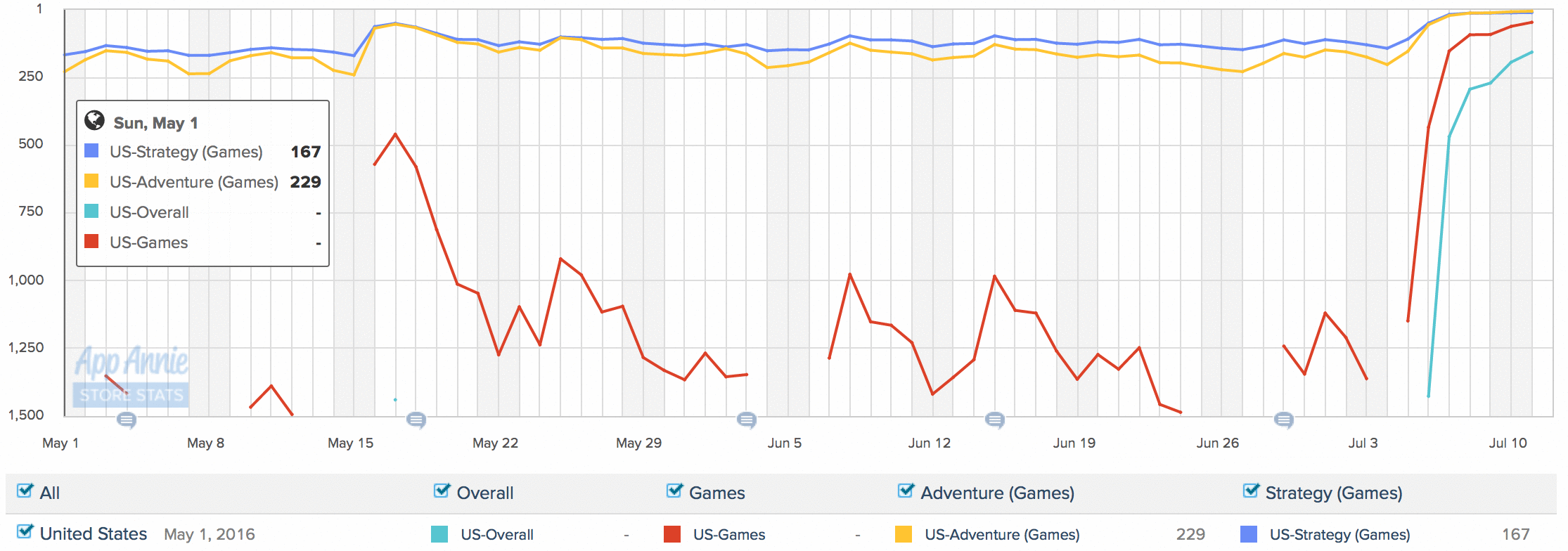Behind the Line: Pokemon Go and alternative gameplay

Unless you’ve been living under a rock, you’ve probably heard about or played Pokemon Go. I’d show you a chart of its first week of downloads, but, no joke, it’s just a straight line at #1. Even I, who have been pretty out of it due to moving, was able to pick up on the seismic impact that this release had. Already there are a lot of comments out there about surprising locations in the game, conspiracies about how your personal information is treated, controversy about crimes using the game, and commentaries about how use of this game looks to others and how this reflects on society.
There’s lots of good discussion to be had about all of those points, but that’s not what I’m here to talk about, since I’m not writing a digest. Instead, I want to look at the essential game play concept, and what that means for future game design.
Pokemon Go’s heritage
Pokemon Go is, to some extent, a Pokemon skinned version of another mobile game by the same developer called Ingress. The core game play concept of both games is that it is based on actual maps of the world, and your actual position reported by your phone’s location service. So, if you need to interact with something down the block, you actually have to get up and go down the block to get to that something.
Now that Niantic has the Pokemon license, Pokemon Go has very quickly become much bigger than Ingress has ever been.

An interesting chart worth displaying, showing Ingress doing well, but not #1, though it also has a massive uptick when Pokemon Go was released on 7/5.
The Innovation
The first thing that this brings to mind is one of the great complaints that my late mother had about video games. She always wanted to see a game that would get a kid to go outside. She was the type to lament kids staying inside, sitting almost motionless, staring at a screen. Since you’re reading this you probably understand that there’s more going on than that, but that’s what she saw.
Pokemon Go, on the other hand, is effectively impossible to play without going outside. Because it ties in to the GPS on your device, and location is the main function. It not only incentivizes, but requires players to go out, move around, and explore around them.
The fascinating thing about this, though, is just how hard it would have been to imagine a game like that working before devices with location services became so common. With an advancement in the hardware, mostly included for maps, a whole new game play mechanic never before seen was created. Furthermore, this is an advancement in hardware that’s several years old. It took some time to put together Ingress, and more time after that to pair it with a license to create Pokemon Go.
What the Future Holds
I may be overly optimistic, but while I don’t know what the next successful GPS game could be, I don’t think that Pokemon Go is the limit for what a GPS based game can do. With the success of Pokemon Go, there will be more to follow. Some will be lame attempts at cash grabs, but others may bring interesting new twists.
We, as an industry, are always looking for ways to gamify new equipment, or to come up with new ways to interact with our hardware in an entertaining way. Almost as soon as the PDP-1 was available at MIT, a student made Spacewar. Cathode Ray Tube screens led to arcade machines. Cheaper electronics led to home consoles. CRT displays led to portable game systems like the GameBoy, or Tiger Handhelds. The internet led to online gaming. IR sensors and motion sensors, or affordable digital cameras led to various forms of motion control. Cameras on devices led to AR games. Right now we are on the cusp of the VR that’s been dreamed about for decades, and there will almost certainly be amazing advancements with that as well.
We can’t be too sure what the next big hardware advancement will be, but one will come. When that happens, we’ll work to gamify it so we can play with it. That will lead to all new kinds of ways we can interact with our games, and each other.
Kynetyk is a veteran of the games industry. Behind the Line is written to help improve understanding of what goes on in the game development process and the business behind it. From “What’s taking this game so long to release”, to “why are there bugs”, to “Why is this free to play” or anything else, if there is a topic that you would like to see covered, please write in to kynetyk@enthusiacs.com








Leave a Reply